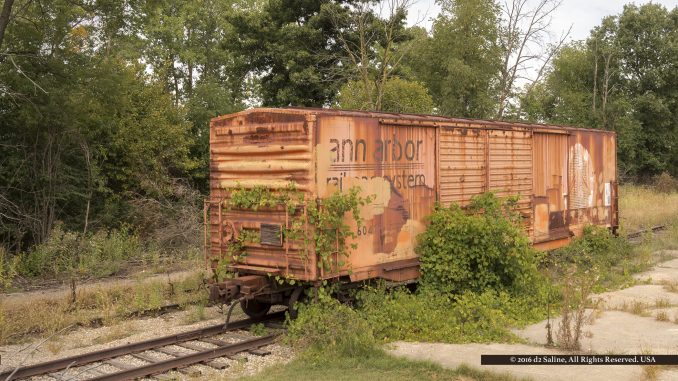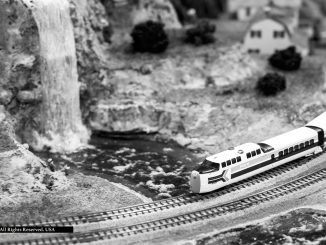
Some would argue that the orange railroad boxcar across from the Saline Library has settled into its place as a local fixture.
Don Maddock, editor of The Ann Arbor Railroad Technical and Historical Association newsletter, recalls having photographed it here in the 1990s. You can also find many detailed markings of our boxcar documented by other individuals online, dated to April of 2010 and December of 2011. [1,2,3]
But now that Saline Maple Oaks has broken ground, how will that change things for the former Ann Arbor Railroad System boxcar number 6047 and the railway branch terminating at Maple Road? [4]
In all likelihood, there will be no change at all.
According to Saline City Engineer Gary Roubal, this boxcar is “regularly used by the railroad,” now owned and operated by Watco Companies. The property on which it sits is one hundred feet wide, running parallel to the rails — and it is also owned and maintained by Watco. [5]
Earlier this month, Watco Communications Director Tracie VanBecelaere provided further information, noting that the company mechanical team continues to utilize both the orange car and that branch of track. “They use it for staging and training,” she said.
In this type of captive service, Mr Maddock predicts that boxcar 6047 still has a good many years of useful life remaining. “These boxcars are pretty simple devices,” he added.
The railroad into Saline dates from 1870, when it was part of a through line running from Ypsilanti to Hillsdale. Most of this has long been abandoned, with only the four-mile-long “Saline Branch” remaining, between Maple Road and Morgan Road, in Pittsfield Township. [6]
Until recently, the Saline auto parts plant Faurecia Interior Systems generated a half dozen or more carloads of business for the Ann Arbor Railroad each day, Don Maddock noted. Although not currently relied upon for shipping by rail, it is unlikely that the tracks will be removed while the potential for future traffic from the plant exists.
“Railroads remain the most economical means for transporting volume commodities over long distances, and the cost of replacing an abandoned rail line often exceeds a million dollars a mile,” he asserted.
In the meantime, the branch remains a valuable asset for the railroad as a track for temporary car storage.
How all of this will be regarded by the incoming neighborhood starting this summer is yet to be seen.
And current conditions that may make storing empty tank cars profitable in early 2018 could give way to more active use in service to a manufacturer such as Faurecia Interiors down the line.
With the branch ending at buffer stops just before Maple Road, it is unlikely that future residents of Saline Maple Oaks will ever see a locomotive this far down the tracks. As far as rail cars go, while any switching would be done at low speeds, the pushing, coupling, and pulling of connected car strings will be loud enough to attract attention.
So far, no one has asked the City Engineering Office about any of this, neither from Saline Maple Oaks nor otherwise.
“But then, nobody’s moved in yet,” observed Gary Roubal.
References
- The Ann Arbor Railroad Technical and Historical Association Home Web Page.
- “AAR XM” Evan McCausland (April 8, 2010) flickr.
- “Ann arbor RR boxcar details” (December 30, 2011) Railfan Wiki.
- Saline Maple Oaks (home page).
- Watco Companies (home page).
- “Saline Depot Museum” Saline Area Historical Society.



